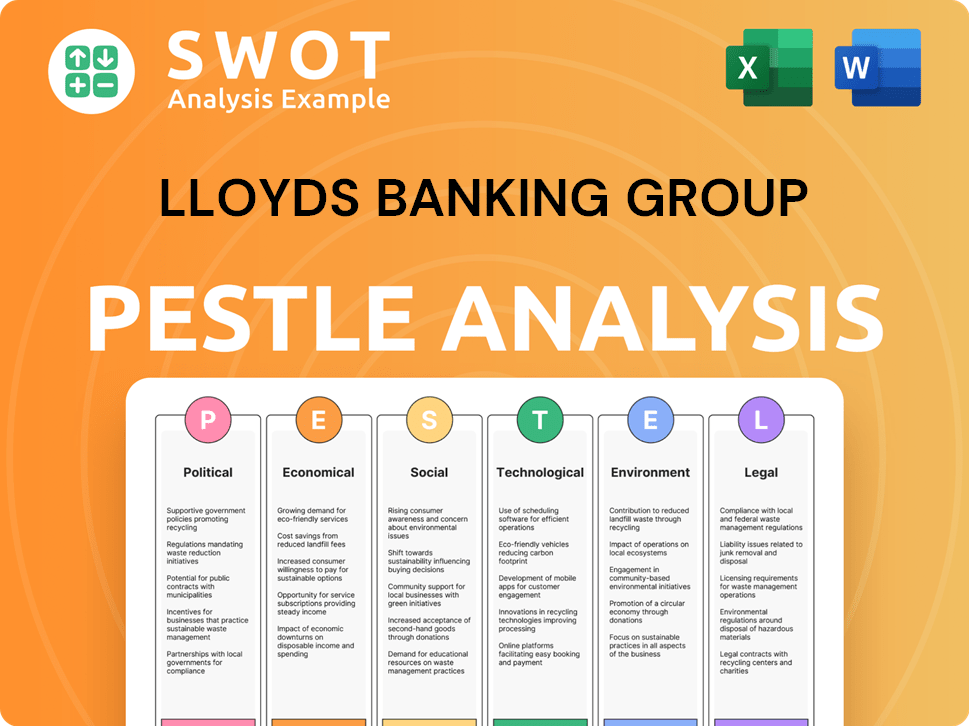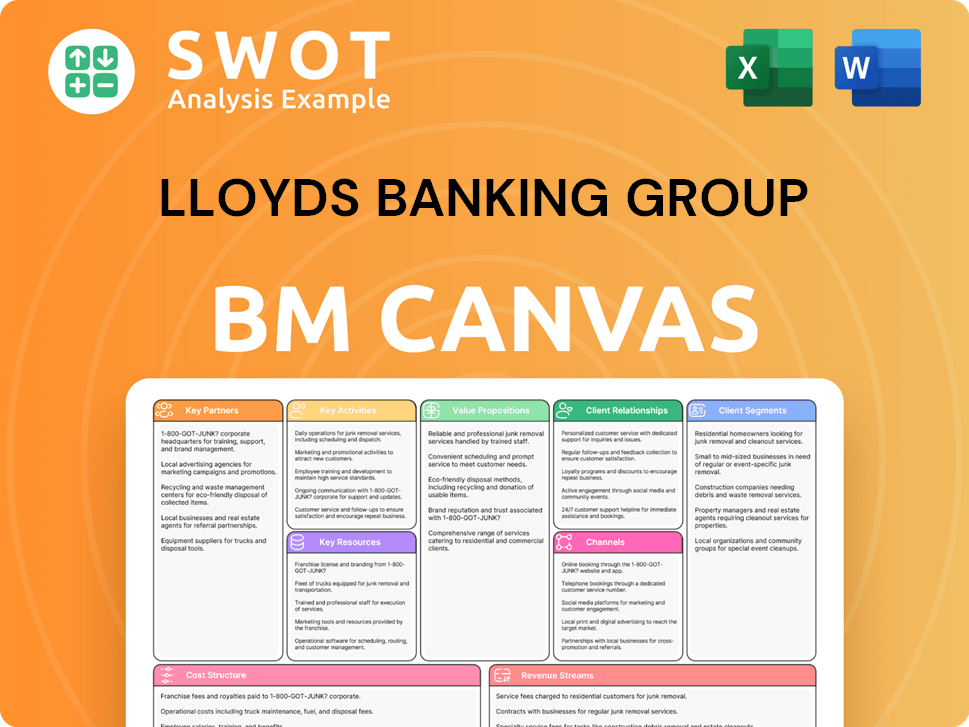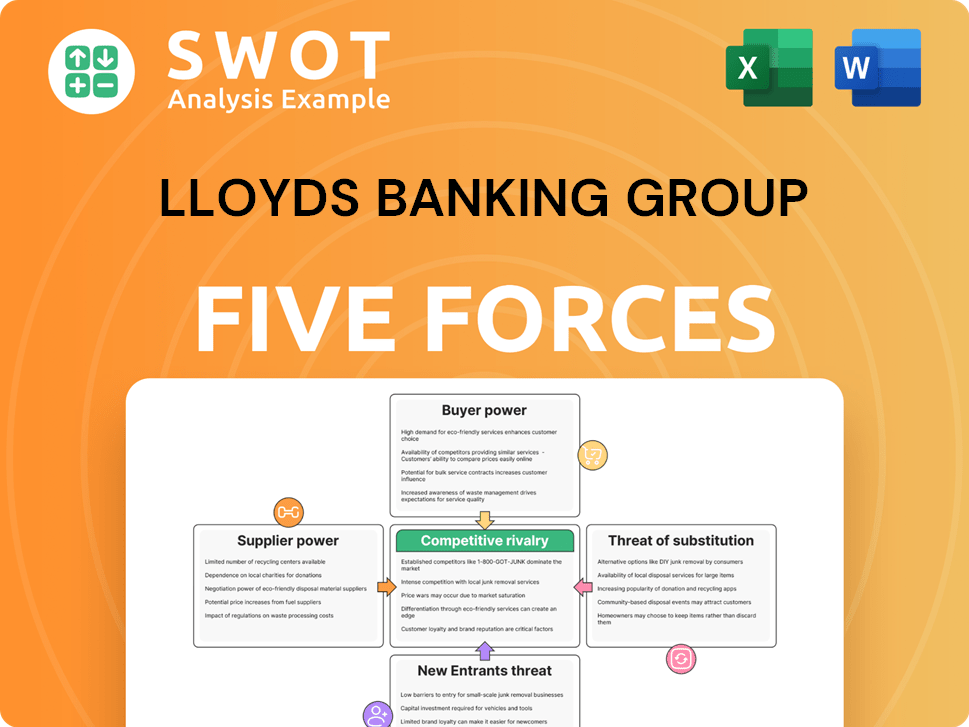Lloyds Banking Group Bundle
Unveiling Lloyds Banking Group: How Does It Really Work?
Lloyds Banking Group, a titan of the UK banking sector, touches the financial lives of millions. With a reported £7.5 billion profit before tax in 2023, its financial prowess is undeniable. But how does this institution, encompassing brands like Lloyds Bank and Halifax, actually operate and generate its impressive returns?

Understanding the Lloyds Banking Group SWOT Analysis is key to grasping its market position. This deep dive will explore its banking operations, dissecting its core functions and diverse revenue streams. Whether you're an investor, customer, or industry observer, gaining insight into the bank structure of Lloyds Bank is crucial in today's dynamic financial landscape, particularly when considering factors like Lloyds Bank share price history and Lloyds Bank mortgage rates comparison.
What Are the Key Operations Driving Lloyds Banking Group’s Success?
Lloyds Banking Group delivers value through a wide array of financial services, catering to individuals, small and medium-sized enterprises (SMEs), corporate clients, and institutional customers. Its core offerings span retail banking, commercial banking, and a significant life, pensions, and insurance division. The Group serves approximately 26 million customers and has a presence in 1.9 million businesses across the UK.
The operational framework of Lloyds Banking Group is extensive and technologically advanced, especially in retail banking. This includes managing a vast network of branches alongside sophisticated digital platforms for online and mobile banking. Commercial banking utilizes dedicated relationship managers for tailored financial solutions, supported by strong credit assessment and risk management. The life, pensions, and insurance arm, primarily through Scottish Widows, involves actuarial expertise and investment management. Digital transformation is key to operational efficiency, with a focus on enhancing customer experience and streamlining internal processes.
Lloyds Banking Group's unique operational approach is defined by its scale, extensive branch network, and digital capabilities, alongside its deep-rooted relationships within the UK market. This integrated model allows for cross-selling opportunities and a holistic customer approach. This results in customer benefits such as convenience, a wide array of financial products, and personalized service, contributing to its market differentiation and strong brand loyalty. For more information, you can explore the Brief History of Lloyds Banking Group.
Retail banking includes current accounts, savings, mortgages, and personal loans. The operational processes involve a vast branch network and advanced digital platforms. Digital engagement is growing, with 19.8 million digitally active users in 2023, including 15.8 million mobile app users.
Commercial banking offers lending, treasury services, and trade finance. Dedicated relationship managers work with businesses to provide tailored financial solutions. Robust credit assessment and risk management frameworks support these operations.
The life, pensions, and insurance arm, primarily through Scottish Widows, involves actuarial expertise, investment management, and claims processing. Wealth management services are also offered to customers. These services contribute to the overall financial services portfolio.
Digital transformation efforts are central to operational efficiency. The focus is on enhancing customer experience and streamlining internal processes. These efforts include improvements in online and mobile banking platforms.
Lloyds Banking Group provides convenience, a wide array of financial products, and personalized service. Its integrated model offers cross-selling opportunities and a holistic approach to customer needs. This strengthens its market position and brand loyalty.
- Extensive branch network combined with digital capabilities.
- Integrated services across retail, commercial, and insurance.
- Strong customer relationships and market presence in the UK.
- Focus on digital transformation and customer experience.
Lloyds Banking Group SWOT Analysis
- Complete SWOT Breakdown
- Fully Customizable
- Editable in Excel & Word
- Professional Formatting
- Investor-Ready Format

How Does Lloyds Banking Group Make Money?
The revenue streams and monetization strategies of Lloyds Banking Group are integral to its financial performance within the UK banking sector. Understanding how Lloyds Bank generates income provides insight into its overall business model and strategic direction. The Group's diverse financial services portfolio supports multiple revenue streams, enabling it to serve a wide range of customers.
Lloyds Banking Group's primary revenue sources include net interest income, fees and commissions, and insurance premium income. These streams reflect the Group's core banking operations and its expansion into insurance and wealth management. The effective management of these revenue streams is crucial for maintaining profitability and shareholder value.
Net interest income is a significant contributor to Lloyds Banking Group's revenue. In 2023, this income stream reached £13.8 billion, demonstrating the bank's ability to generate profit from its lending activities. Fees and commissions, another key source, brought in £4.7 billion in 2023, stemming from various banking services. Insurance premium income, mainly from Scottish Widows, also plays an important role.
Lloyds Banking Group employs several monetization strategies to enhance its revenue streams. These strategies include cross-selling, tiered pricing, and digital transformation initiatives. These approaches help the Group optimize its financial performance and customer engagement.
- Cross-Selling: The Group leverages cross-selling opportunities across its brands. For example, offering a Scottish Widows pension product to retail banking customers.
- Tiered Pricing: Tiered pricing for banking products and services, based on account balances or service usage.
- Digital Transformation: Strategic focus on digital transformation to drive efficiency and create new revenue opportunities through enhanced digital product offerings.
- Capital Generation: Strong capital generation, with a pro forma CET1 capital ratio of 13.7% and a capital generation of 296 basis points in 2023, enabling shareholder returns.
Lloyds Banking Group PESTLE Analysis
- Covers All 6 PESTLE Categories
- No Research Needed – Save Hours of Work
- Built by Experts, Trusted by Consultants
- Instant Download, Ready to Use
- 100% Editable, Fully Customizable

Which Strategic Decisions Have Shaped Lloyds Banking Group’s Business Model?
The journey of Lloyds Banking Group has been shaped by key milestones and strategic decisions, significantly impacting its operational and financial landscape. A critical move was the 2009 acquisition of HBOS, which expanded its market share and customer base, although it also introduced challenges during the financial crisis. The Group has also been investing heavily in digital transformation to improve customer experience and streamline operations.
The company has navigated various challenges, including regulatory changes and economic uncertainties. In 2023, Lloyds Banking Group demonstrated strong financial performance, reflecting its resilient business model. This resilience is crucial in a competitive market, including traditional banks and fintech disruptors.
Lloyds Banking Group's competitive advantages are multifaceted, including a strong brand built over centuries, fostering customer trust across its brands. Its extensive distribution network, combining physical branches with advanced digital platforms, provides unparalleled reach across the UK. The Group's comprehensive product offering creates a powerful ecosystem effect.
The acquisition of HBOS in 2009 was a pivotal event, expanding the Group's market share. The Group has also focused on digital transformation, investing in technology to enhance customer experience. These moves have been essential in adapting to market changes and maintaining a competitive edge.
The Group has focused on risk management and maintaining a robust capital position. It has adapted its business model to meet evolving customer expectations. A strong focus on digital capabilities is also a key strategic move to improve efficiency and customer service.
The company benefits from a strong brand and an extensive distribution network. Economies of scale allow for efficient operations and cost management. Lloyds offers a comprehensive product range, encouraging customers to consolidate their financial needs.
In 2023, Lloyds Banking Group delivered strong financial results despite economic challenges, demonstrating its resilient business model. The Group continues to focus on its strategic priorities, including optimizing its cost base and enhancing its digital capabilities. For more insights, see the Marketing Strategy of Lloyds Banking Group.
Lloyds Banking Group's strengths include a trusted brand, extensive distribution networks, and a comprehensive product offering. The Group's strategies focus on digital transformation, risk management, and adapting to customer needs.
- Digital transformation to improve customer experience and operational efficiency.
- Maintaining a strong capital position and robust risk management practices.
- Focusing on customer needs and adapting to market changes.
- Optimizing the cost base and enhancing digital capabilities.
Lloyds Banking Group Business Model Canvas
- Complete 9-Block Business Model Canvas
- Effortlessly Communicate Your Business Strategy
- Investor-Ready BMC Format
- 100% Editable and Customizable
- Clear and Structured Layout

How Is Lloyds Banking Group Positioning Itself for Continued Success?
Within the UK financial services sector, Lloyds Banking Group holds a prominent position. It has a substantial market share in key areas like mortgages and retail banking. The strong brand recognition of Lloyds Bank and Halifax contributes to high customer loyalty. Its extensive reach within the domestic market strengthens its standing against both traditional and challenger banks.
The Group faces risks from regulatory changes, including those related to capital requirements and consumer protection. New competitors, such as fintech companies, pose a threat, as does technological disruption. Macroeconomic factors like interest rate fluctuations also influence its performance. For instance, the company expects its net interest income to be around £13.0 billion in 2024.
Lloyds Banking Group is a leading player in the UK banking sector. It has a significant market share in mortgages and retail banking. The company's strong brand recognition, including Lloyds Bank and Halifax, supports high customer loyalty, which strengthens its position in the financial services industry.
Regulatory changes, such as those related to capital requirements and anti-money laundering, pose a risk. Competition from fintech companies and technological disruption are also threats. Macroeconomic factors, like interest rate fluctuations, can affect lending volumes and net interest income. The company’s financial performance is also exposed to changes in the UK economy.
Lloyds Banking Group focuses on digital transformation to enhance customer experience and efficiency. It targets growth in segments like wealth management and commercial banking. The company is committed to sustainability and responsible banking. The Group aims to become a more digitally-led, customer-centric organization.
The company is investing in digital transformation. It is focusing on growth in wealth management and commercial banking. Sustainability and responsible banking are also key priorities. The strategic plan includes optimizing the cost base and enhancing digital capabilities.
Lloyds Banking Group is working to become a more digitally-led, customer-centric organization. The company is leveraging data and analytics to offer personalized services and build customer relationships. Leadership emphasizes a commitment to shareholder returns while investing for long-term growth. For more details on the company's strategic approach, you can explore the Growth Strategy of Lloyds Banking Group.
The Group's strategic plan is centered on optimizing its cost base and enhancing its digital capabilities. In 2023, the Group reported a statutory profit after tax of £5.5 billion. The company expects its net interest income to be around £13.0 billion in 2024.
- Focus on digital transformation to improve customer experience.
- Targeted growth in wealth management and commercial banking.
- Commitment to sustainability and responsible banking practices.
- Emphasis on shareholder returns and long-term growth investments.
Lloyds Banking Group Porter's Five Forces Analysis
- Covers All 5 Competitive Forces in Detail
- Structured for Consultants, Students, and Founders
- 100% Editable in Microsoft Word & Excel
- Instant Digital Download – Use Immediately
- Compatible with Mac & PC – Fully Unlocked

Related Blogs
- What are Mission Vision & Core Values of Lloyds Banking Group Company?
- What is Competitive Landscape of Lloyds Banking Group Company?
- What is Growth Strategy and Future Prospects of Lloyds Banking Group Company?
- What is Sales and Marketing Strategy of Lloyds Banking Group Company?
- What is Brief History of Lloyds Banking Group Company?
- Who Owns Lloyds Banking Group Company?
- What is Customer Demographics and Target Market of Lloyds Banking Group Company?
Disclaimer
All information, articles, and product details provided on this website are for general informational and educational purposes only. We do not claim any ownership over, nor do we intend to infringe upon, any trademarks, copyrights, logos, brand names, or other intellectual property mentioned or depicted on this site. Such intellectual property remains the property of its respective owners, and any references here are made solely for identification or informational purposes, without implying any affiliation, endorsement, or partnership.
We make no representations or warranties, express or implied, regarding the accuracy, completeness, or suitability of any content or products presented. Nothing on this website should be construed as legal, tax, investment, financial, medical, or other professional advice. In addition, no part of this site—including articles or product references—constitutes a solicitation, recommendation, endorsement, advertisement, or offer to buy or sell any securities, franchises, or other financial instruments, particularly in jurisdictions where such activity would be unlawful.
All content is of a general nature and may not address the specific circumstances of any individual or entity. It is not a substitute for professional advice or services. Any actions you take based on the information provided here are strictly at your own risk. You accept full responsibility for any decisions or outcomes arising from your use of this website and agree to release us from any liability in connection with your use of, or reliance upon, the content or products found herein.